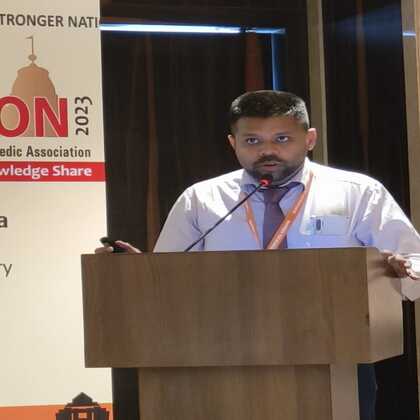Sprains and Strains: All You Need To Know
Learn the key differences between sprains and strains, their causes, symptoms, and effective treatment options. Then, get back to your active lifestyle by preventing these common injuries.

Written by
Last updated on 3rd Jul, 2025
Introduction
Ever wonder what the difference is between a sprain and a strain? Although these terms are often used interchangeably, they actually refer to distinct injuries with different causes, symptoms, and treatment approaches. In this blog article, we will highlight the intricacies of sprains and strains and explain the details of these very common injuries.
What is a Sprain?
A sprain is a stretching or tearing of ligaments — the tough bands of fibrous tissue that connect two bones in your joints. The most common location for a sprain is in your ankle.
What is a Strain?
A strain is an injury to a muscle or a tendon—the fibrous tissue that connects muscles to bones. Minor injuries may involve overstretching a muscle or tendon, while more serious injuries may involve partial or complete tears in these tissues. Sometimes called pulled muscles, strains commonly affect the muscles at the back of the thigh (hamstrings) and lower back.
The difference between a strain and a sprain is that a strain involves an injury to a muscle or to the band of tissue that attaches a muscle to a bone, while a sprain injures the bands of tissue that connect two bones.
Causes of Sprains and Strains
Sprains and strains are prevalent injuries that can affect anyone, from athletes to everyday individuals. Here are some of the most common causes:
1. Common Causes of Sprains
Falling: Sudden slips can lead to joint injuries.
Twisting: Abrupt movements can overstretch ligaments.
Trauma: Direct impact or collision during sports.
2. Common Causes of Strains
Overstretching: Muscles or tendons stretched beyond their limits.
Heavy Lifting: Improper technique can lead to muscle strain.
Repetitive Motions: Activities that involve repetitive use can cause fatigue and injury.
Risk Factors of Sprain and Strains
Understanding the risk factors associated with these injuries is crucial for prevention and management.
Here are some key contributors:
Age: The elderly are prone to sprains and strains since they have lower muscular mass and flexibility.
Physical Activity: Individuals who participate in high-impact activities or those with poor physical conditioning are at higher risk.
Warm-up and Cool-down: Skipping warm-up and cool-down routines can heighten the risk of injury.
Underlying Conditions: Conditions like arthritis or osteoporosis can make you more susceptible to sprains and strains.
Symptoms of Sprains and Strains
Identifying these symptoms at an early stage can aid in the appropriate management and rehabilitation of the injury. Here are some symptoms to look out for:
1. Symptoms of Sprains
Symptoms of sprain includes:
Pain: Localised pain around the affected joint.
Swelling: Prominent swelling in the injured area.
Bruising: Discoloration due to bleeding under the skin.
Limited Mobility: Difficulty moving the joint.
"Pop" Sensation: A feeling or sound of a "pop" at the time of injury.
2. Symptoms of Strains
Symptoms of strain includes:
Pain: Tenderness and pain in the affected muscle.
Stiffness: Reduced flexibility in the muscle.
Swelling: Swelling around the injured area.
Weakness: Decreased strength in the muscle.
Consult Top Doctor for Sprains and Strains
Diagnosis of Sprains and Strains
A thorough physical examination performed by a healthcare professional is usually sufficient to diagnose sprains and strains. The professional will assess your symptoms, examine the affected area, and potentially order imaging tests like X-rays or MRI scans to rule out other conditions.
Treatment Options
Sprains and strains are common injuries during physical activity, sporting events, or even everyday living. Knowing appropriate treatment is the key to recovery and avoidance of evolving complications.
1. Immediate First Aid
Apply the R.I.C.E method: Rest, Ice the area for 20 minutes every 2 hours, Compress with a bandage, and elevate the injured limb to reduce swelling.
2. Medical Treatments
Over-the-counter analgesics like paracetamol or NSAID gels can alleviate pain. In severe cases, medical intervention may include physical therapy or surgery.
3. Rehabilitation and Physical Therapy
A structured rehabilitation program focuses on restoring strength and flexibility, often involving exercises tailored to the injury, ensuring a safe return to activity. Gentle range-of-motion exercises are encouraged to prevent stiffness, and stretching exercises are gradually introduced to improve flexibility.
Prevention Strategies
Following are some practical strategies for mitigating the risk of muscle strains, emphasizing the crucial role of proper training and equipment.
1. Tips to Prevent Sprains and Strains
Some common tips to prevent sprain and strain are as follows:
Wear Appropriate Footwear: Choose shoes with good traction and support to lower the chance of sliding or twisting an ankle.
Warm-Up and Stretch: Always perform a proper warm-up and stretching routine before engaging in physical activities to prepare your muscles and joints.
Avoid Hazardous Conditions: Be mindful of your surroundings and avoid uneven surfaces or obstacles that could lead to falls.
Strength Training: Incorporate strength training exercises to enhance muscle stability around joints.
Use Proper Techniques: When lifting or performing physical tasks, use correct techniques to avoid overexertion.
Take Breaks: Allow your body to rest and recover, especially during prolonged activities.
Stay Hydrated: Drink plenty of water to keep your muscles hydrated and functioning optimally.
Maintain a Balanced Diet: A well-balanced diet supports muscle health and overall physical performance.
2. Importance of Proper Training and Equipment
Skill Development: Proper training helps individuals learn the correct techniques and movements, reducing the risk of injury.
Equipment Quality: Using the right equipment, such as supportive shoes and protective gear, can significantly decrease the likelihood of sprains and strains.
Awareness of Limits: Training makes people aware of their physical limitations, promoting safer participation in sports and activities.
When to See a Doctor?
Knowing when to seek medical attention is crucial for proper recovery when dealing with strains and sprains.
1. Identifying Severe Cases
If you experience severe pain, swelling, or inability to use the affected area, consult a doctor immediately.
2. Understanding Chronic Conditions
Persistent pain
Recurring injuries
Lack of improvement after initial treatment may signify a chronic condition.
This could involve underlying issues like ligament instability, tendonitis, or arthritis. Therefore, it is essential to consult a physician to diagnose the root cause and develop a comprehensive treatment plan. With early intervention, a more successful treatment plan can be ensured, and further issues can be avoided. Always prioritize your health, and don't hesitate to seek help when in doubt!
Complications and Long-term Effects
While both strains and sprains can be painful, they often heal well with proper care. However, long-term complications can arise, especially if the injury is severe or not managed effectively.
1. Potential Complications
Some potential complications are as follows:
Chronic pain: Pain that lasts even after initial recovery can seriously affect daily life.
Instability: Several strains or sprains weaken tendons and ligaments, leading to persistent joint instability.
Arthritis: Severe injuries can increase the risk of developing arthritis in the knee joint later in life.
2. Impacts on Daily Life
The effects of these injuries influence various aspects of a person's life and may cause:
Instability
difficulty with weight-bearing activities can disrupt work, exercise, and everyday tasks.
Muscle pain
Weakness
Limited range of motion can hinder daily activities
Lifestyle and Home Remedies
Taking care of strains and sprains at home is crucial for a speedy recovery. RICE (Rest, Ice, Compression, Elevation) is your best friend. Rest the injured area, apply ice for 20 minutes every 2-3 hours, use a compression bandage, and elevate the limb above your heart.
Nutrition plays a vital role. Focus on protein and vitamin C-rich foods to support tissue repair. Stay hydrated by drinking plenty of water for a speedy recovery and to maintain overall health.
Myths and Misconceptions
Many misconceptions surround sprains and strains. Here are some common myths and the
Myth#1- Crutches Help Sprains Heal Faster
Putting weight on the injured joint can promote healing better than avoiding it, while delaying joint use may delay recovery despite potentially benefiting pain management.
Myth #2: Being Active Means You Won't Get a Sprain
This is completely untrue. Because of their frequent use and abrupt movements during physical activities, athletes and energetic people are more susceptible to sprains and strains.
Myth #3 Rest Will Heal Any Sprain or Strain
While rest is a part of recovery, moderate to severe sprains and strains benefit from professional treatment.
Understanding these myths helps in effective treatment and recovery, ensuring you return to your activities sooner!
Conclusion
Sprains and strains are common injuries that can affect anyone, from athletes to everyday individuals. Symptoms include pain, swelling, bruising, limited mobility, and "pop" sensation. Diagnosis involves a thorough physical examination by a healthcare professional. Identifying severe cases and knowing chronic conditions is important while going for treatment.
In conclusion, sprains and strains are common injuries that can affect daily life. Understanding the risk factors, proper treatment, and lifestyle recommendations can help prevent further complications and ensure a speedy recovery.
Consult Top Orthopaedician
Consult Top Orthopaedician
Dr. Anil Sharma
Orthopaedician
42 Years • MBBS, MS Orthopedics
New Delhi
AAKASH MEDSQUARE, New Delhi

Dr. Sourav Kumar Pal
Orthopaedician
3 Years • MBBS, MS(ORTHO)
Malda
B S ORTHO, Malda

Dr. Pradeep Lucas
Orthopaedician
7 Years • MBBS, Diploma in Orthopaedics, Fellowship in DFSI
Bengaluru
Revival Multispeciality Clinic, Bengaluru

Dr. Manoj Dinkar
Orthopaedician
15 Years • MBBS, Dip (Orthopaedics)
New Delhi
THE DOCTORS NESST, New Delhi

Dr. Mriganka Ghosh
Orthopaedician
11 Years • MD (Physician), DNB (Orthopaedics)
Howrah
Dr Mriganka Mouli Ghosh, Howrah
Consult Top Doctor for Sprains and Strains
Dr. Anil Sharma
Orthopaedician
42 Years • MBBS, MS Orthopedics
New Delhi
AAKASH MEDSQUARE, New Delhi

Dr. Sourav Kumar Pal
Orthopaedician
3 Years • MBBS, MS(ORTHO)
Malda
B S ORTHO, Malda

Dr. Pradeep Lucas
Orthopaedician
7 Years • MBBS, Diploma in Orthopaedics, Fellowship in DFSI
Bengaluru
Revival Multispeciality Clinic, Bengaluru

Dr. Manoj Dinkar
Orthopaedician
15 Years • MBBS, Dip (Orthopaedics)
New Delhi
THE DOCTORS NESST, New Delhi

Dr. Mriganka Ghosh
Orthopaedician
11 Years • MD (Physician), DNB (Orthopaedics)
Howrah
Dr Mriganka Mouli Ghosh, Howrah
